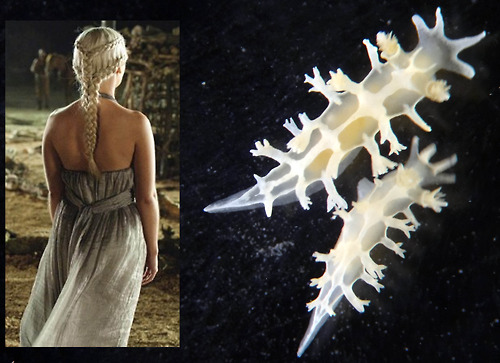Filtered by: Scitech
SciTech
Game of Thrones' Khaleesi is a new sea slug species
By MACY AÑONUEVO
Here's a queen of dragons of an entirely different sort.
A newly-discovered species of sea slug—more properly called a nudibranch—has just been named Tritonia khaleesi, in honor of the silver-haired character Daenerys Targaryen from George R. R. Martin's "A Song of Ice and Fire" book series (which has since been adapted by HBO into the "Game of Thrones" TV series).
In the Journal of the Marine Biological Association of the United Kingdom, Brazilian scientists Felipe de Vasconcelos Silva, Victor Manuel de Azevedo, and Helena Matthews-Cascon describe T. khaleesi as:
"Tritonia khaleesi sp. nov. is up to 12 mm long, with a slender white body, of which the notum is covered with one broad white band extending from between the eyes and veil to the tail; veil with 4 velar appendages; retractable white rhinophores; rhinophoral sheath with fleshy extension; seven pairs of branchial plumes; the anus is located between the 3rd and 4th gills on the right side, and the genital opening is under the 2nd gill. Internally, T. khaleesi sp. nov. is distinguished from other tritoniids by jaws with 10–14 rows of denticles on the inner lips, absence of stomach plates and the radular formula 32 × 2–5.1.1.1.2–5 teeth. Tritonia khaleesi sp. nov. is the only Tritonia that possesses a unicuspid rachidian tooth as an adult."
The species was found off northeast Brazil.
In an interview with Papelpop, de Vasconcelos Silva explains the rationale behind the name:
“The strand of silver on the back of the slug is reminiscent of Khaleesi's braids of silver hair, especially in the last episode of the first season of (HBO's Game of Thrones). Besides its silver color, the species is one of the smallest sea slugs, just as Khaleesi is described (in the books) as small and juvenile.”

PHOTO CREDIT: Gaymerbr via Tumblr
Nudibranchs, commonly known as "sea slugs", are shell-less molluscs belonging to the family Gastropoda. Nudibranchs are so-named for the "naked gills" or branchial plumes found on their backs. They are generally small, ranging in size from 6 mm to 31 cm.
The Philippines alone is home to 944 known species of nudibranchs, 52% of which are undescribed. Their striking colors, used to advertise their unpalatability to predators, make them popular subjects for underwater photographers. — TJD, GMA News
More Videos
Most Popular




